Sheet Metal Building Photos
When steel was introduced into
construction at the beginning of the 20th century, a new affordable
building material became available for roofing. Metal was rolled
into flat sheets, stiffened by ridges, then dipped into molten
zinc to protect them from corrosion. All of this, when fabricated
by an automated process in a steel mill, produced the cheapest
and most available metal roofing material on the market, and
its use grew tremendously. Over time, it was also used as building
siding, particularly on industrial buildings, where fire concern
was an issue.
This is the Big River Sheet
Metal factory in Lynnwood. It is a plywood shell, covered with
the sheet metal material, which is attached with Silicone adhesive.
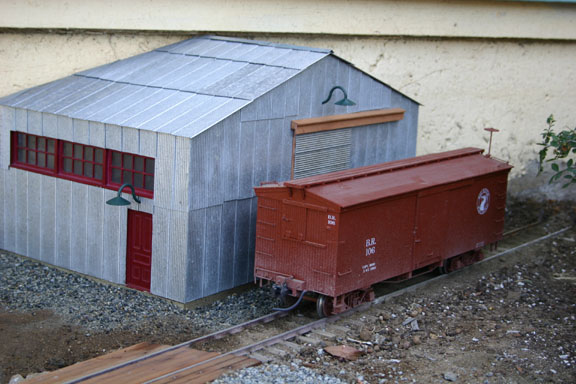 This freight house is my latest building.
The structure is made with "Jig Stone" molds, casting
Quick-Crete. The roof has a plywood substructure, and the sheet
metal is attached with Liquid Nails Adhesive. For the first time,
I tried etching the galvanized metal to accelerate rusting. Click
HERE for
details.
This freight house is my latest building.
The structure is made with "Jig Stone" molds, casting
Quick-Crete. The roof has a plywood substructure, and the sheet
metal is attached with Liquid Nails Adhesive. For the first time,
I tried etching the galvanized metal to accelerate rusting. Click
HERE for
details.
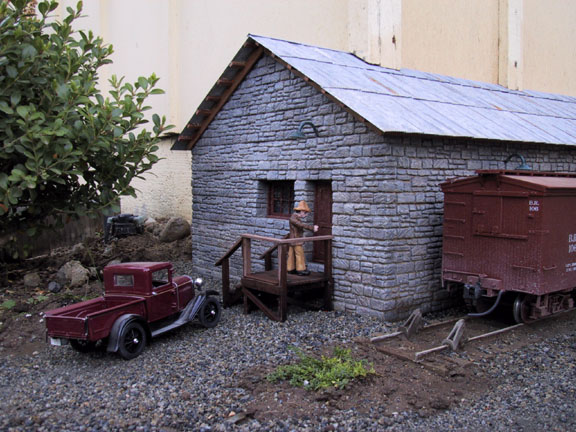 This industrial building has a 1/2"
marine plywood sub-structure. The sheet metal panels are applied
with Liquid Nails Outdoor Adhesive. The peak at each end is filled
with redwood board and batten construction. It has been outside
for over 2 years and the galvanized has only begun to chalk off.
This industrial building has a 1/2"
marine plywood sub-structure. The sheet metal panels are applied
with Liquid Nails Outdoor Adhesive. The peak at each end is filled
with redwood board and batten construction. It has been outside
for over 2 years and the galvanized has only begun to chalk off.
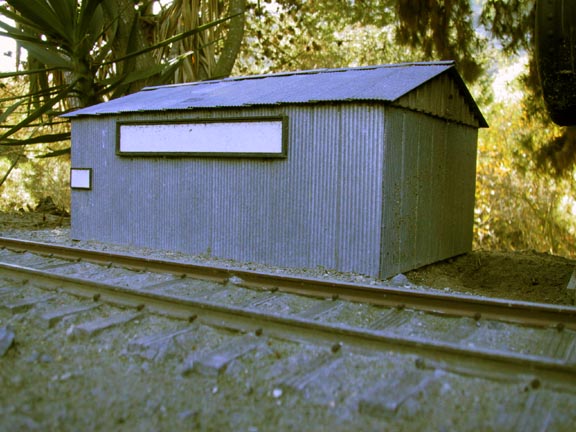 Acme Products is a large industrial
industrial complex built as a flat against the base of the house.
The sub-structure is 1/4" tempered masonite. The sheet metal
panels are applied with Liquid Nails Outdoor Adhesive. The Masonite
panels are glued to the concrete footing of the house with the
same adhesive. The loading bay cover structure is made from pine.
Acme Products is a large industrial
industrial complex built as a flat against the base of the house.
The sub-structure is 1/4" tempered masonite. The sheet metal
panels are applied with Liquid Nails Outdoor Adhesive. The Masonite
panels are glued to the concrete footing of the house with the
same adhesive. The loading bay cover structure is made from pine.
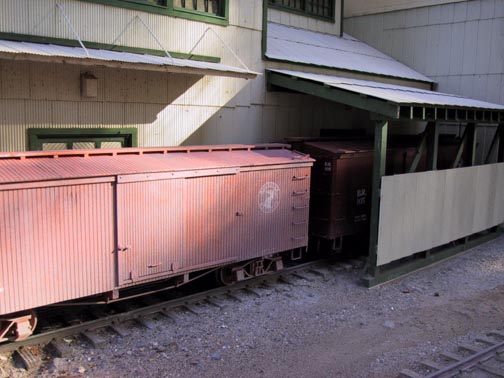 This is a detail of Acme Products.
This is a detail of Acme Products.
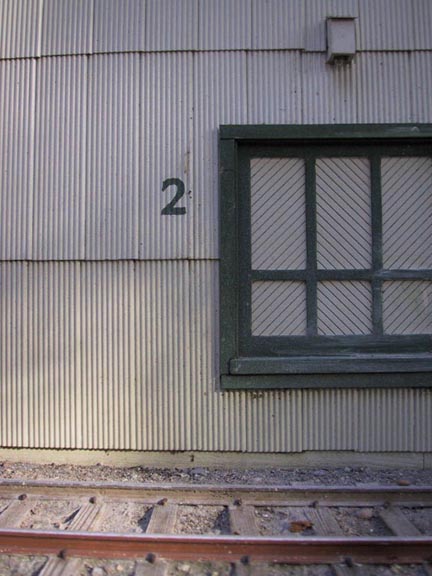 Alexa Borowski, age 11, and her replica of Lincoln
Works, a structure in Lincoln NM on her family's property. The
basic structure is made of fired ceramic, the roof is corrugated
steel. She says the clay structure did have some problems firing. The
gable ends sagged in but this is largely invisible due to the
roof overhangs. Probably should have been made thicker. The fired
clay structure was fixed to a Masonite base with liquid nails.
The roof panels were cut from the Masonite and liquid nailed
to the gable ends. The corrugations were similarly attached.
The porch roof was again masonite, supported by 14 square spruce
posts. The whole was painted
Alexa Borowski, age 11, and her replica of Lincoln
Works, a structure in Lincoln NM on her family's property. The
basic structure is made of fired ceramic, the roof is corrugated
steel. She says the clay structure did have some problems firing. The
gable ends sagged in but this is largely invisible due to the
roof overhangs. Probably should have been made thicker. The fired
clay structure was fixed to a Masonite base with liquid nails.
The roof panels were cut from the Masonite and liquid nailed
to the gable ends. The corrugations were similarly attached.
The porch roof was again masonite, supported by 14 square spruce
posts. The whole was painted
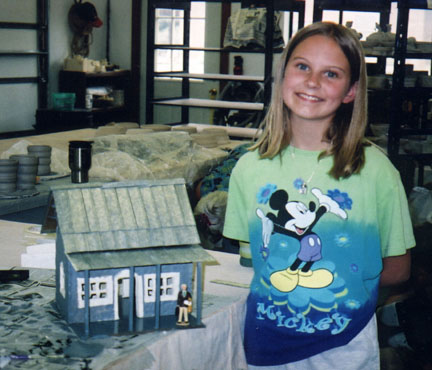 Three models by Sue Piper, Lakeside, Calif.
Sheriff's Office
Three models by Sue Piper, Lakeside, Calif.
Sheriff's Office
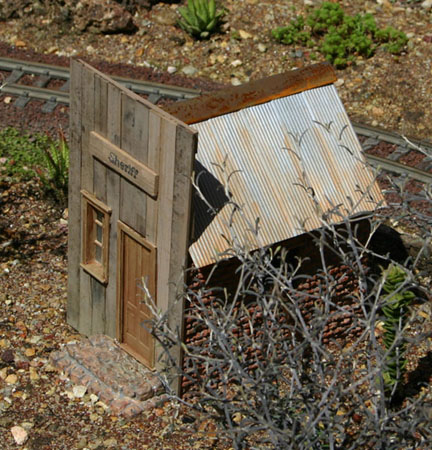 Crossing Tower
Crossing Tower
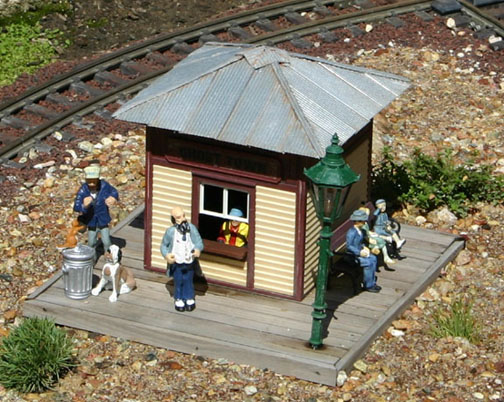 Village
Village
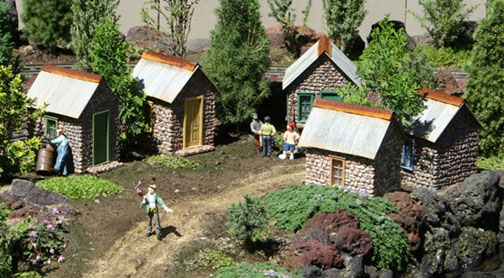 Grain Elevator by Bob Westover,
San Diego, Calif. Elevator silos are heavy duty water pipe, with
plywood based.
Grain Elevator by Bob Westover,
San Diego, Calif. Elevator silos are heavy duty water pipe, with
plywood based.
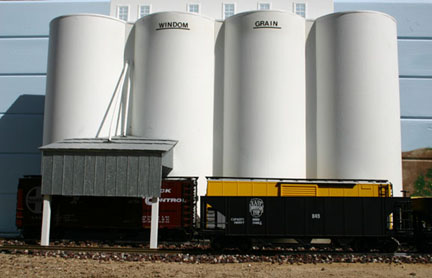
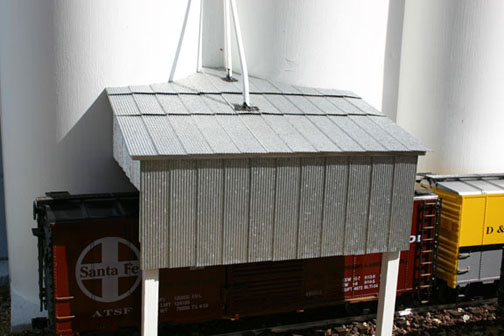 Produce Warehouse by Bob Westover.
Plywood base structure. Inspired by growing up in Kansas.
Produce Warehouse by Bob Westover.
Plywood base structure. Inspired by growing up in Kansas.
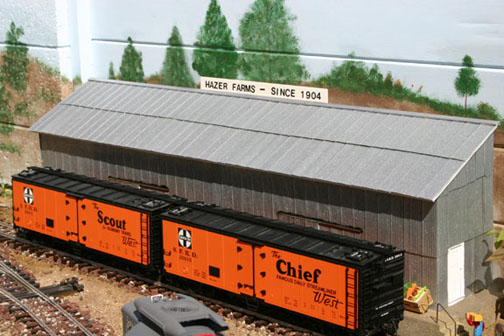
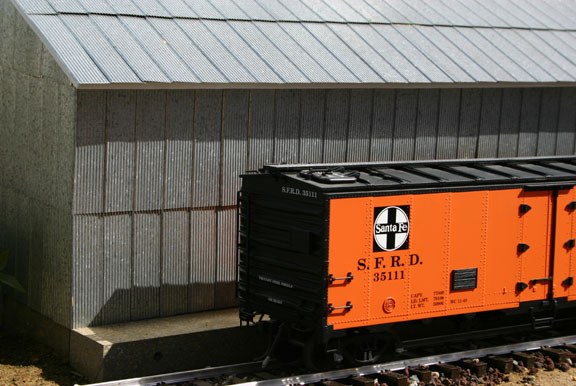 Mine by Bob Westover. This sub-structure is built from
1/4" luan plywood. The siding is plastic sheeting, and the
roof is galvanized metal, both are applied with Liquid Nail Adhesive.
Mine by Bob Westover. This sub-structure is built from
1/4" luan plywood. The siding is plastic sheeting, and the
roof is galvanized metal, both are applied with Liquid Nail Adhesive.
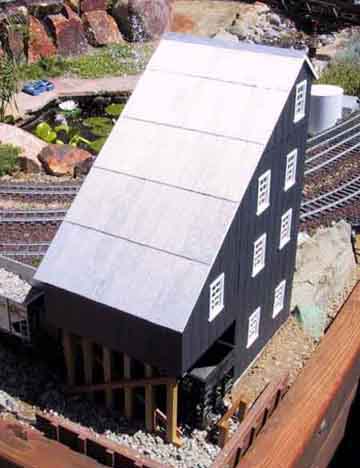 This sawmill, built by D Meeks, has an exposed framework
of redwood timbers. The sheet metal is nailed on with Atlas track
nails.
This sawmill, built by D Meeks, has an exposed framework
of redwood timbers. The sheet metal is nailed on with Atlas track
nails.
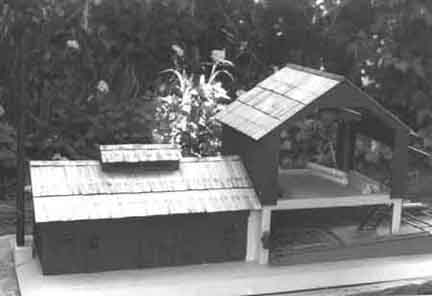 The Matchless Mine building, built by M. Hutson, is
framed out of 1/2" x 3/4" pine trim. The siding is
1/2" redwood, stained with a mixture of India ink and rubbing
alcohol. The roofing is attached with Liquid Nails. The metal
is weathered with a very fine rust powder made by dissolving
steel wool pads in a saline solution, and then letting it dry
out. The metal is painted with Floquil Rust. The rust dust is
sprinkled in while the paint is still wet, then sealed with Dullcote,
and finished with the same wash of India ink and alcohol as the
siding. With time, the Dullcote slowly wears off, and the rust
dust begins to oxidize again, creating rust streaks down the
corrugated steel.
The Matchless Mine building, built by M. Hutson, is
framed out of 1/2" x 3/4" pine trim. The siding is
1/2" redwood, stained with a mixture of India ink and rubbing
alcohol. The roofing is attached with Liquid Nails. The metal
is weathered with a very fine rust powder made by dissolving
steel wool pads in a saline solution, and then letting it dry
out. The metal is painted with Floquil Rust. The rust dust is
sprinkled in while the paint is still wet, then sealed with Dullcote,
and finished with the same wash of India ink and alcohol as the
siding. With time, the Dullcote slowly wears off, and the rust
dust begins to oxidize again, creating rust streaks down the
corrugated steel.
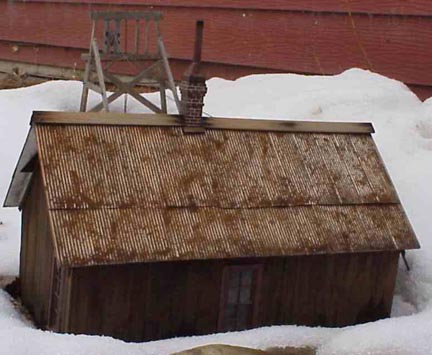 This goose barn, built by M. Hutson, is framed with 1/2"x
3/4" trim.The floor is Plexiglas and S-core foam board forms
the base for the roof and walls, which are then covered with
the sheet metal. The exterior is painted with Krylon ultra-flat
black and ruddy brown primer. The roofing got the same treatment
as the Matchless Mine above.
This goose barn, built by M. Hutson, is framed with 1/2"x
3/4" trim.The floor is Plexiglas and S-core foam board forms
the base for the roof and walls, which are then covered with
the sheet metal. The exterior is painted with Krylon ultra-flat
black and ruddy brown primer. The roofing got the same treatment
as the Matchless Mine above.
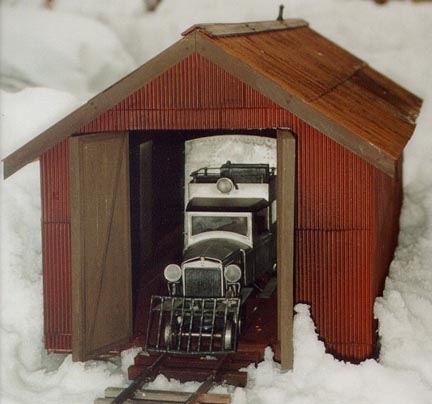 This engine house is built in the same manner
as the two buildings above.
This engine house is built in the same manner
as the two buildings above.
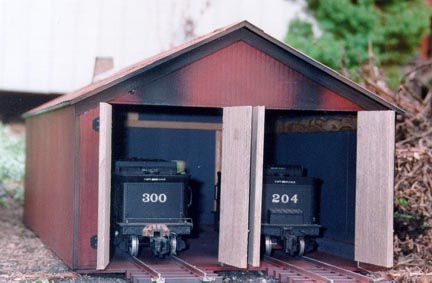
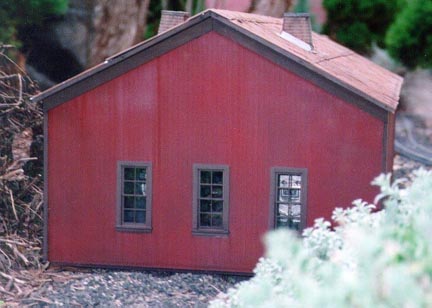
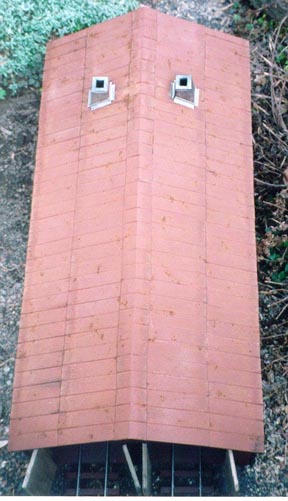
Return to Products




















